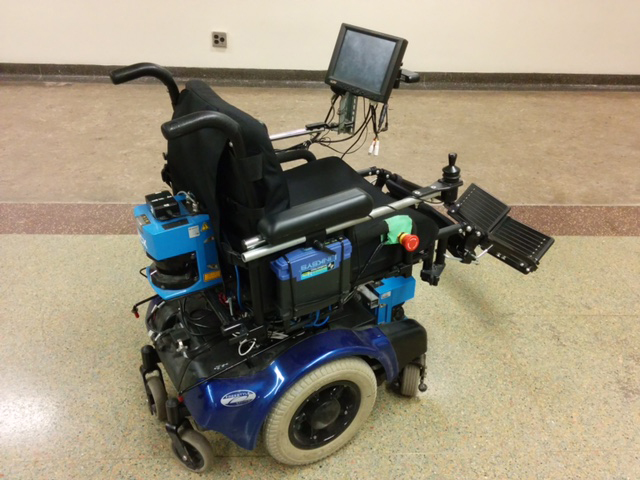
About 3.8 million working-age Canadians (aged 15 to 64) self-identified as disabled in 2012. That’s almost 14 per cent of us, or one in ten. Some disability activists say those of us who are not disabled are just “temporarily abled,” meaning that many of us are going to need assistance as we grow older. That assistance will take the form of a wheelchair, hopefully a smart one.
In the 1950s, Canadian inventor George Klein built the first electric wheelchair – considered one of the greatest inventions in the history of Canadian science and engineering. It is admired around the world for improving the mobility and quality of life of people with mobility issues.
Now Computer Engineering professor Joëlle Pineau and colleagues from other institutions are working on advancing Klein’s work with the next generation of user-friendly wheelchairs.
The SmartWheeler and Multi-modal intelligent wheelchair combines robotics and artificial intelligence to give disabled people more autonomy and increasing their safety.
The project focuses on human–robot interaction, and on reliable control of the intelligent wheelchair. The goal is to develop a flexible interface between the user and the wheelchair so that disabled people can move around their homes and their communities safely and effectively.
Martin Gerdzhev is a graduate student who works with Pineau in the Learning and Reasoning Lab in Computer Science. “The smart chair is an autonomous wheelchair similar to the self-driving car,” he says. “Originally the idea was to build it to be driven mostly indoors, but we would like to make it possible for people to drive it in and out of doors, so people can go shopping or to the library.

“We have three lasers installed on our chair that gauge objects within a range of up to 80 metres, so that the user and the chair can detect obstacles easily,” Gerdzhev continues. “We realize that more and more people are going to need this kind of technology to be able to function and have a life, even if their mobility is reduced.”
The SmartWheeler features various ways for the user to direct it and for the chair to interact with the environment around it. A touch screen is used to give commands to the wheelchair either via a map of the environment, or through a button-based interface. The laser range finders measure the distance to obstacles around the wheelchair, by emitting invisible light in a horizontal plane and measuring the time it takes to reflect from objects.
An on-board joystick gives users the traditional method of control while a wireless joystick allows for remotely controlling the wheelchair from a distance. The kinect is a motion sensing input device based upon a webcam-style add-on peripheral that enables users to control and interact with their console/computer through gestures and spoken commands. It uses a camera and a 3D depth sensor to detect places of interest (e.g., people, doors, stairs, etc.) and to recognize gestures.
The research in the Reasoning and Learning Lab at McGill, co-directed by Pineau, Prakash Panangaden and Doina Precup, is broadly concerned with the study of probabilistic systems.
- Ongoing research areas include:
- Mapping, navigation, and control in public spaces
- Person detection and tracking
- Flexible parking maneuvers
- Gesture recognition for caregiver commands
- Classification of activities based on sensor information
Pineau is also the leader of the theme “Human” Group at the Canadian Field Robotics Network (NCFRN) which promotes research on human–robot interaction in the context of field robotics, or robots outside in the real world. A major focus of the activities is directed towards the development of assistive robot platforms (smart wheelchairs, telepresence robots), based on the expertise of the team members.
Pineau is a founding member of two multi-disciplinary ventures that led to the development of robotic assistants for elderly and disabled individuals: the Nursebot platform and the SmartWheeler initiative. These projects have involved substantial field work in clinical environments both in Canada and the US. Pineau has developed unique robotic and artificial intelligence expertise to address chronic disorders using clinical data.
It’s estimated there are over 4 million users of powered wheelchairs in the U.S. alone and up to 40 per cent of them find daily steering and maneuvering tasks to be difficult or impossible. Developing a smart wheelchair could improve the mobility of a lot of people. The smart wheelchair can be used as a flexible platform to investigate a wide spectrum of cognitive robotics problems.
The Smartwheeler project is a collaboration between McGill , Ecole Polytechnique Montréal (Richard Gourdeau), Université de Montréal (Louise Demers, Dahlia Kairy, Robert Forget, Paula Rushton), Institut de réadaptation en déficience physique de Québec (François Routhier), Lucie-Bruneau Rehabilitation Centre, and the Constance-Lethbridge Rehabilitation Centre.
